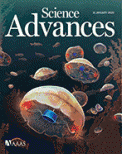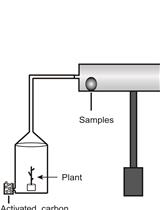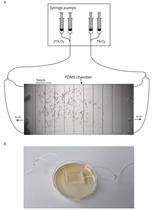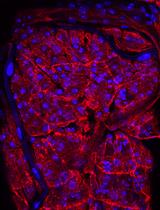- EN - English
- CN - 中文
Developing Biohybrid Robotic Jellyfish (Aurelia aurita) for Free-swimming Tests in the Laboratory and in the Field
开发的生物合成机器人水母在室内和室外的自由游泳测试
发布: 2021年04月05日第11卷第7期 DOI: 10.21769/BioProtoc.3974 浏览次数: 5151
评审: Chen FanArif Md. Rashedul KabirAnonymous reviewer(s)
Abstract
Biohybrid robotics is a growing field that incorporates both live tissues and engineered materials to build robots that address current limitations in robots, including high power consumption and low damage tolerance. One approach is to use microelectronics to enhance whole organisms, which has previously been achieved to control the locomotion of insects. However, the robotic control of jellyfish swimming offers additional advantages, with the potential to become a new ocean monitoring tool in conjunction with existing technologies. Here, we delineate protocols to build a self-contained swim controller using commercially available microelectronics, embed the device into live jellyfish, and calculate vertical swimming speeds in both laboratory conditions and coastal waters. Using these methods, we previously demonstrated enhanced swimming speeds up to threefold, compared to natural jellyfish swimming, in laboratory and in situ experiments. These results offered insights into both designing low-power robots and probing the structure-function of basal organisms. Future iterations of these biohybrid robotic jellyfish could be used for practical applications in ocean monitoring.
Keywords: Jellyfish (水母)Background
Despite the importance of the ocean and need to track its changing conditions, over 80% of the ocean remains largely unobserved and unexplored (Kim et al., 2012; Malve, 2016; NOAA, 2020a and 2020b). Further exploration is fundamental to reveal physical and biogeochemical processes in the ocean. This can improve our understanding of climate change, as well as provide new sources of food, medicine, and energy (NOAA, 2020b).
Traditional methods for ocean monitoring and exploration include remotely operated vehicles (ROVs) and autonomous underwater vehicles (AUVs). ROVs and AUVs have been used to track anthropogenic effects on the ocean, with the potential to monitor changes in the ecosystem (Wynn et al., 2014; Teoh et al., 2018; Plum et al., 2020; Sanchez et al., 2020). These vehicles can commonly reach ranges of depths up to 6 km (Wynn et al., 2014), although examples such as the Nereus have approached 11 km (WHOI, 2014). However, in many cases these technologies are still limited by their power consumption and cannot be used in more environmentally sensitive areas of the ocean, where the vehicles could potentially produce or incur damage (Page et al., 2017). Such areas include small crevices, or even open spaces where natural debris can cause vehicle damage (Teoh et al., 2018; Plum et al., 2020). As an alternative tool, biologically inspired AUVs offer advantages that address such limitations, including high power consumption and disruptive wake signatures (Fish, 2020). These bioinspired vehicles use animal body forms and principles, within the broader frame of biomimicry.
Bioinspired robotics study the biological systems that act as models from which machines are designed. Biological systems are adapted to selective pressure and environmental conditions (Darwin, 1859), and engineers can apply these natural designs to address similar engineering problems (Fish, 2020). Within bioinspired robotics, biohybrid approaches integrate both biological and robotic components (Yang et al., 2018). These biological constructs have the capability both to improve robotics by taking advantage of existing tools in nature, and to use engineering tools to advance our knowledge of the natural world.
At present, there are two approaches to building biohybrid systems. The first is to incorporate live cells or tissues (Nawroth et al., 2012; Morimoto et al., 2018). Ricotti et al. (2017) describes this bottom-up approach for a comprehensive list of devices actuated by living cells, from bacteria and motile cells, cardiomyocytes, skeletal muscles, and insect self-contractile tissues. These approaches offer advantages, such as increased controllability and new potentials in environmental sensing, but require specific media for survival (Webster et al., 2016a and 2016b; Morimoto et al., 2018). Another approach is to integrate electronics into live insects (Sato and Maharbiz, 2010; Dirafzoon et al., 2015; Latif et al., 2016; Li and Sato, 2018; Saha et al., 2020; Tadepalli et al., 2020) and higher order animals (Valero-Sarmiento et al., 2017). The external control of insect locomotion has incited a growing collection of “cyborg” cockroaches (Holzer and Shimoyama, 1997; Bozkurt et al., 2016; Latif and Bozkurt, 2017), beetles (Sato et al., 2009; Cao et al., 2016; Li et al., 2016; Vo Doan et al., 2018; Li et al., 2018; Cao and Sato, 2019), and moths (Bozkurt et al., 2009; Tsang et al., 2010).
The control of aquatic animals has additional potentials for robotics. First, as previously described, biohybrid swimming robots can expand ocean monitoring to areas which traditional AUVs and ROVs cannot reach because of size constraints, damage to the vehicle, or impact on the wildlife (Teoh et al., 2018; Plum et al., 2020). Second, using marine invertebrates offers insights into modes of locomotion that arose early in the evolutionary history of animals (Halanych, 2015).
Animal models for aquatic vehicles
The choice of model organism offers different advantages and disadvantages in design considerations for bioinspired aquatic vehicles. For example, although large fishes and manta rays can travel fast speeds over long distances (Fish, 2020), the integration of robotic control onto these organisms requires extensive training, personnel, and access to these animals, which introduce more ethical considerations. Although aquatic invertebrates may swim slower and be more affected by the weight and buoyancy of self-contained robotic devices, these invertebrates offer advantages in their simplicity. Jellyfish offer additional benefits because of their low cost of transport (COT), one metric of energy efficiency defined as the mass-specific energy input per distance traveled (Gemmell et al., 2013).
Jellyfish as a model organism
Cnidarian jellyfish fossils have revealed the conservation of the medusan body structure since the Middle Cambrian period, despite over 505 million years of evolutionary pressure (Cartwright et al., 2007). Because the jellyfish bell structure and locomotion are linked to multiple behaviors, including feeding and escaping from predators (Arai, 1997), jellyfish swimming provides a unique model for evolutionary and ecological insights.
In addition to the energy efficiency exhibited by natural jellyfish, biohybrid robotic jellyfish offer new advantages to robotics because jellyfish are naturally found in a variety of environments, including thousands of meters below surface (the limit of current ocean exploration depths), which the animals can traverse without a swim bladder for pressure equilibration (NOAA, 2016). Although jellyfish are relatively slow swimmers with speeds on the order of cm/s, some species such as Stomolopus meleagris can exhibit directional swimming, migration, and maintain position against tidal currents, which are useful traits for an underwater vehicle (Shanks and Graham, 1987).
The microelectronic systems described in this protocol can increase swimming speeds up to threefold (Xu and Dabiri, 2020; Xu et al., 2020a). Moreover, because AUVs and ROVs have demonstrated high speeds on field tests (traveling on the order of m/s), both traditional and new biohybrid tools can be used synergistically for future deployments, where AUVs and ROVs can tow biohybrid robotic jellyfish to certain environments before releasing the biohybrid robots into smaller spaces or areas in which the vehicles cannot reach. This can expand our current capabilities in ocean monitoring to provide new insights into the natural world and changing climate.
Furthermore, a major advantage of using jellyfish over animals such as manta rays and fish is their lower taxonomic order and relatively tractable nervous systems. Although further ethical considerations of invertebrate research are merited, jellyfish are invertebrates exempt from evaluation by an Institutional Animal Care and Use Committee. Even among jellyfish clades, scyphomedusae (true jellyfish) possess the most diffuse nervous system organization, comprising eight sensory structures and two nerve nets: the motor nerve net (MNN) and diffuse nerve net (DNN) (Arai, 1997; Satterlie, 2011; Katsuki and Greenspan, 2013). Thus, the moon jellyfish species Aurelia aurita offers advantages as simple model organisms that do not possess a centralized nervous system, brain, or pain receptors; and have potential capabilities that could benefit current underwater technologies.
Biology of Aurelia aurita (moon jellyfish)
Jellyfish are invertebrates with a simple body structure comprising a flexible bell and a muscle monolayer that lines the subumbrellar bell surface. Specifically, the moon jellyfish Aurelia aurita is a species of scyphozoa, the Cnidarian class of true jellyfish with medusae possessing radial symmetry about the oral-aboral body axis (Arai, 1997) and have the ability to exhibit directional travel, useful for underwater vehicles (Hamner et al., 1994).
Jellyfish do not possess a centralized nervous system (CNS) or brain; rather, A. aurita have distributed, non-polarized neuronal networks (Arai, 1997; Satterlie, 2011; Katsuki and Greenspan, 2013; Byrne, 2017). These nervous systems include eight rhopalia, a motor nerve net (MNN), and a diffuse nerve net (DNN). The rhopalia (also known as swim pacemakers or marginal sensory structures) are equally distributed in indentations along the bell margin and directly activate the MNN, which then activates bidirectional waves of muscle contractions. Stimulation of one rhopalium is sufficient to activate the entire MNN (Passano, 1965; Mackie and Meech, 1995).
To swim, jellyfish contract their ring-shaped musculature to decrease the volume of the subumbrellar cavity, thus expelling water and providing the motive force for acceleration (Satterlie, 2002), with additional suction-based propulsion from vortical structures (Gemmell et al., 2015a). Oblate medusae such as Aurelia also rely heavily on the bell margin to create a paddling mode of locomotion (Colin and Costello, 2002; Costello et al., 2020).
Jellyfish primarily move vertically using pulsed propulsion sufficient for survival, i.e., passively catching prey, while their horizontal movement largely depends on ocean currents and waves (Satterlie, 2002). A. aurita also possess radial muscles that potentially contribute to non-symmetric thrust, thereby distorting individual vortex rings to cause turning maneuvers (Gemmell et al., 2015b). Jellyfish are energetically efficient swimmers because of passive energy recapture, in which the animals still propel forward in a relaxed state without added energy input (Gemmell et al., 2013; Gemmell et al., 2018).
Robotic control of live jellyfish swimming
The following protocols describe the steps to build a biohybrid robotic jellyfish, comprising a microelectronic swim controller embedded in live A. aurita medusae, and subsequent laboratory and in situ experiments to calculate vertical swimming speeds. Design considerations include minimizing costs by using inexpensive off-the-shelf components, keeping the robotic system as compact and neutrally buoyant as possible, and using a two-electrode system and symmetric activation pattern to incite unidirectional swimming. See Figure 1 for representative images and schematics of the biohybrid robotic jellyfish and microelectronic system.
Using these methods, we have determined that the user control of jellyfish can increase their swimming speeds up to three times, both in the absence of flow (in the laboratory) and in coastal conditions (Xu and Dabiri, 2020; Xu et al., 2020a). The existence of both faster and potentially more efficient swimming in jellyfish has implications for future studies in the ecology and evolution of basal organisms, beyond A. aurita. The results suggest that robotic systems can be used to uncover latent capabilities in organisms, and organisms can be used in biohybrid capabilities in ocean environments. Furthermore, biohybrid robotic jellyfish consume less external power per mass compared to other swimming robots in literature (Xu and Dabiri, 2020). This suggests that biohybrid designs can be used to improve the energy efficiency of robots to address extant challenges in robotics, which include power consumption and regeneration after damage (Yang et al., 2018).
This work describes the entire process toward building and implementing a biohybrid robotic jellyfish, with a proof of concept that these constructs can be deployed in real ocean environments. This provides the basis for future practical applications in the ocean, with the ultimate goal to track markers of climate change. For comprehensive information on the usage and execution of these protocols, refer to Xu and Dabiri (2020) for the swim controller design and laboratory experiments, and Xu et al. (2020a) for field experiments.

Figure 1. Biohybrid robotic jellyfish. A. Representative image of a biohybrid robotic jellyfish deployed in coastal conditions in the Atlantic Ocean. B. Schematic of the biohybrid robotic jellyfish to compare, with the animal bell labeled in white, swim controller housing in blue, two electrodes in red, and wooden pin in yellow. C. Two microelectronic swim controllers (front one is active, as shown by the red LEDs). Figures adapted from Xu et al. (2020a and 2020b).
Materials and Reagents
TinyLily mini processor (TinyCircuits, catalog number: ASM2101 )
TinyLily light-emitting diodes (LED) 0402 (TinyCircuits, catalog number: ASL1001-LR )
10-mAh ultra-light lithium polymer (LiPo) battery cell (PowerStream Technology, catalog number: PGEB201212 )
Weights and buoyant materials (e.g., stainless steel washers and cork)
Toothpicks (Good Old Values Bamboo Toothpicks, Pack of 1000)
Platinum rod, 254.0-μm diameter (A-M Systems, catalog number: 711000 )
Polypropylene housing (e.g., 2.11-cm diameter cap of a 15 ml NuncTM conical centrifuge tube, Thermo ScientificTM, catalog number: 339650 ; and polypropylene plastic sheets cut to a corresponding circular shape)
Perfluoroalkoxy alkane (PFA)-coated silver wire, 76.2-μm diameter bare, 139.7-μm diameter coated (A-M Systems, catalog number: 785500 )
Hot glue (e.g., Gorilla hot glue sticks, Gorilla Glue)
Instant Ocean® Sea Salt (Instant Ocean, Spectrum Brands, catalog number: SS15-10, stored at room temperature)
Equipment
Soldering iron, solder, helping hands tool, and tweezers
Candle or open flame
Hot glue gun (e.g., cordless hot glue gun, Neu Master, catalog number: FQ-009 )
Parchment paper (e.g., Quillon parchment paper, Uline, catalog number: S-19145 )
Multimeter (e.g., Fluke 115 Field Technicians Digital Multimeter)
Acrylic tank (Envision Acrylics, Inc., custom design with dimensions 1.8 m × 0.9 m × 0.9 m)
Refractometer (e.g., Milwaukee MA871 Digital Brix Refractometer, catalog number: MW-MA871 )
Ladder
Net (e.g., a large fish net with a handle, or a custom-built fish net to match the dimensions of the bottom of the tank, with strings and handles to pull upward)
Plastic containers with lids (e.g., 86 oz clear food storage container, Basix)
Insulated Styrofoam container (e.g., Thermo Chill insulated carton with foam shipper, medium, 12” × 10” × 7”, Polar Tech Industries, catalog number: 227C )
Cyber-shot DSC-RX100 (Sony, catalog number: DSCRX100/B )
Gates AX100 Underwater Housing (Gates Underwater Products, catalog number: AX100 )
Background boards (e.g., black foam board, 36 × 48”, Uline, catalog number: S-19381 and white foam board 20 × 30 × 3/16” or 5 mm, Navy Penguin)
Rope tied to a dive weight
Zip ties (e.g., red and yellow nylon zip ties)
SCUBA diving equipment (e.g., mask, snorkel, fins, wetsuit, regulator, compressed air tanks, dive computer)
Software
Arduino (Arduino, https://www.arduino.cc/)
MATLAB (MathWorks, https://www.mathworks.com/)
ImageJ (National Institutes of Health, https://imagej.nih.gov/ij/)
Procedure
文章信息
版权信息
© 2021 The Authors; exclusive licensee Bio-protocol LLC.
如何引用
Readers should cite both the Bio-protocol article and the original research article where this protocol was used:
- Xu, N. W., Townsend, J. P., Costello, J. H., Colin, S. P., Gemmell, B. J. and Dabiri, J. O. (2021). Developing Biohybrid Robotic Jellyfish (Aurelia aurita) for Free-swimming Tests in the Laboratory and in the Field. Bio-protocol 11(7): e3974. DOI: 10.21769/BioProtoc.3974.
- Xu, N. W. and Dabiri, J. O. (2020). Low-power microelectronics embedded in live jellyfish enhance propulsion. Sci Adv 6(5): eaaz3194.
分类
生物物理学 > 生物工程
您对这篇实验方法有问题吗?
在此处发布您的问题,我们将邀请本文作者来回答。同时,我们会将您的问题发布到Bio-protocol Exchange,以便寻求社区成员的帮助。
Share
Bluesky
X
Copy link













